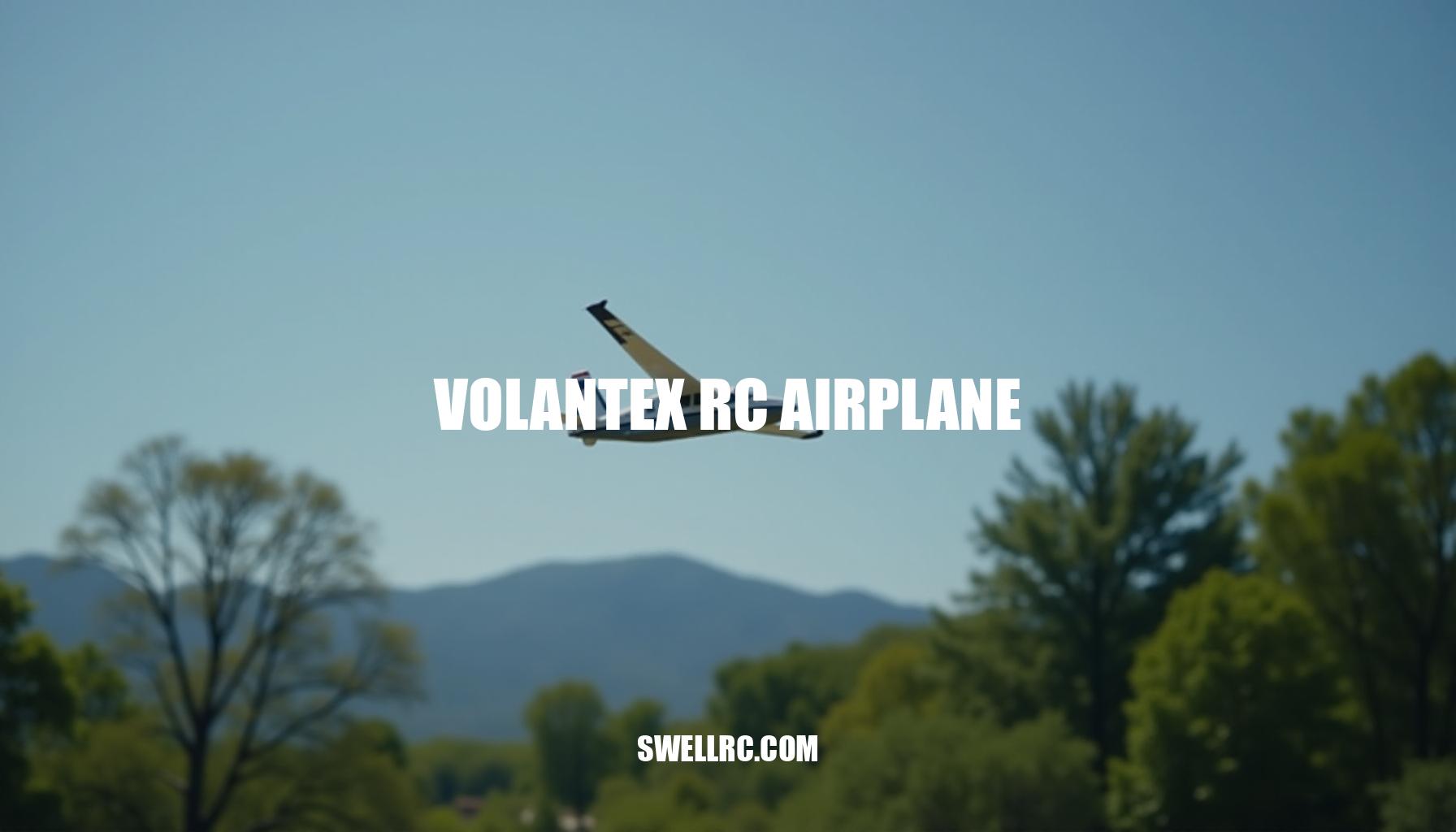Volantex RC Airplane Review: A Beginner’s Guide to Affordable and Durable Flight
I first picked up a Volantex RC airplane on a whim after a Sunday fun-fly, expecting a casual toss-around trainer. I didn’t expect to be this impressed. The moment I launched it, the airplane tracked like it was on rails—calm, predictable, and surprisingly confident in light gusts.
That set me off on a week-long rabbit hole of testing different Volantex models, comparing specs, and talking with fellow pilots. In this Volantex RC airplane review, you’ll learn how these electric RC airplanes are built, how they perform in real air, which models suit beginners versus experienced pilots, and how Volantex stacks up against popular alternatives. If you’re just getting started or shopping small, you might also peek at the compact Wltoys Cessna 182 F949, a classic gateway model: https://www.swellrc.com/wltoys-cessna-182-f949/.
By the end, you’ll have a clear, experience-backed picture of where Volantex shines—and which version is right for your field and flying style. Whether you’re diving into the world of remote control airplanes or looking to expand your fleet of hobby aircraft, this guide will help you confidently choose the perfect RC plane.
The Secrets Behind Volantex’s Smooth Flight
From the first taxi roll, Volantex designs feel balanced and reliable, especially for those seeking durable RC airplane options. Most of their trainers sport a high-wing layout with generous dihedral wing, crafted from resilient EPO foam RC planes airframes reinforced by carbon or fiberglass spars. These reinforcement rods stiffen the wing efficiently without adding unnecessary weight, enhancing aerodynamic stability during flight.
EPO foam hits the sweet spot for beginners and enthusiasts alike: it’s tough enough to absorb shocks from nose-overs yet light enough to maintain low stall speeds, making the planes forgiving and easy to control. Many Ready-To-Fly (RTF) packages include the Xpilot 3-axis stabilization system, which helps dampen over-corrections—ideal for new pilots or windy environments. After several test flights in breezy conditions, the stability felt impressively forgiving; banking into the wind was progressive and the recovery from maneuvers was smooth and drama-free.
Why it matters for learners: Low wing loading combined with the dihedral effect strengthens self-righting tendencies, so the plane naturally wants to stabilize itself mid-flight. The reinforcement rods prevent flutter at higher speeds, and EPO’s springiness means minor bumps don’t end your session prematurely.
Quick comparison (Volantex Ranger vs a typical Freewing foam sport model):
| Feature | Volantex Ranger 600 | Typical Freewing Foam Sport Model |
|---|---|---|
| Wing layout | High-wing, strong dihedral | Low/mid-wing, lower dihedral |
| Material | EPO foam with carbon spar | EPO foam (often stiffer, heavier) |
| Stabilization | Xpilot gyro on many RTFs | Usually receiver-dependent |
| Typical weight class | Light | Medium to heavy |
| Stall behavior | Gentle, easy to recover | Sharper, needs pilot input |
| Wind handling | Good for size class | Better when heavier; higher speed |
In summary, Volantex’s smart combination of EPO foam RC planes, dihedral wing design, and strategically placed reinforcement rods results in excellent aerodynamic stability and durability. This structural recipe not only builds pilot confidence quickly but also leaves ample room to transition into sportier flying by reducing stabilization assistance and exploring more advanced maneuvers.
Exploring the Volantex Fleet
Volantex offers an impressive range of ready-to-fly RC planes and PNP RC planes that cater to pilots at every skill level, from beginners to advanced flyers. Their lineup spans compact trainers to large soaring models, allowing you to find the perfect fit for your flying style and environment.
Beginner-friendly options include the Volantex Sport Cub 500, a friendly high-wing trainer that offers brisk performance to keep the learning experience engaging. Comparable beginner models to consider are the Aeroscout S 2 1.1 m RTF. For park flying, the Volantex Ranger 400 and Volantex Ranger 600 come in micro to mini sizes with stabilization features that make them feel more stable in the air.
The Ranger 400, in particular, surprised many with its efficient flight time during low-throttle cruising on calm evenings.
Intermediate pilots can enjoy the sporty scale aesthetics of the Volantex Warbird series, such as the P-51 Mustang, T-28, and F4U Corsair models with 750–1000 mm wingspans. These are still manageable thanks to gyro assist. The larger Volantex Ranger 1200–1400 models provide more stability in wind, smooth soaring experiences, and excellent visibility in flight.
Advanced and specialty flyers will appreciate the Volantex Ranger 2000, a two-meter class cruiser known for its efficient glide and extended endurance. It’s perfect for catching light thermals and excellent for immersive FPV setups. If you’re interested in exploring different styles, Nexa RC planes offer large-scale balsa and composite models, while the V-22 Osprey RC plane brings tiltrotor excitement.
Broader VTOL RC plane options and classic kits from World Models also enrich the selection for seasoned pilots.
| Model | Wingspan | Battery | Flight time | Control range | Skill |
|---|---|---|---|---|---|
| Volantex Sport Cub 500 | ~500 mm | 2S 300–400 mAh | 10–12 min | 200–400 m | Beginner |
| Volantex Ranger 400 | ~400 mm | 1S–2S 300–400 mAh | 10–14 min | 150–300 m | Beginner |
| Volantex Ranger 600 | ~600 mm | 2S 300–450 mAh | 12–15 min | 200–400 m | Beginner |
| Volantex Warbird 750 (P-51/T-28) | ~750 mm | 2S–3S 800–1000 mAh | 8–12 min | 300–600 m | Intermediate |
| Volantex Ranger 2000 | ~2000 mm | 3S 2200 mAh | 25–40+ min | 500–1000 m | Intermediate–Advanced |
Note: Flight times and control ranges vary based on setup, weather, and throttle discipline, but this guide should help you match your field size and flying ambitions to the ideal Volantex airframe.
Taking the Sky — Real Flight Insights
What struck me first was balance: Volantex trainers track straight with minimal trim, roll into turns without dropping a wing, and recover from overbank gracefully. The control smoothness is smooth rather than twitchy, and the stabilization feature helps you keep the horizon level while you learn throttle and rudder coordination. As you progress, reducing gyro assist awakens the airplane—offering snappier turns, wider envelopes, and cleaner lines, enhancing overall flight performance.
Beginner ease vs expert play
- Beginners: Use 3‑axis stabilization and low rates. High-wing dihedral and low wing loading create a natural “self-correcting” rhythm, which increases stability in wind and reduces the need for constant corrections.
- Experienced pilots: Dial down or disable gyro, add a click of expo, and push into wind for extended energy management. On larger fields, the Ranger 2000 rewards gentle thermal hunting like a mini-sailplane.
Lessons learned across repeated sessions include launching with some authority, trimming once at half throttle, and resisting the urge to yank and bank. By following these RC flight tips, you’ll cover more sky with fewer corrections and land with volts to spare. For a taste of more advanced, long-range profiles and heavy-lift camera setups, the Sonicmodell Skyhunter is a helpful reference point: Sonicmodell Skyhunter.
| Model | Flight time | Control distance | Crash resilience |
|---|---|---|---|
| Ranger 400 | 10–14 min | 150–300 m | High for size (EPO, light) |
| Ranger 600 | 12–15 min | 200–400 m | High |
| Warbird 750 | 8–12 min | 300–600 m | Medium (faster landing speeds) |
| Ranger 2000 | 25–40+ min | 500–1000 m | Medium-High (sturdy but larger mass) |
Tip: In 8–12 mph winds, the 600–1200 mm class feels lively but composed, illustrating excellent stability in wind. Micros under 500 mm are happiest in calmer air or with short upwind legs and downwind glides, optimizing flight performance and control sensitivity.
Affordability Meets Quality
One of Volantex’s biggest strengths lies in their exceptional value for money. Their Ready-to-Fly (RTF) bundles are genuinely flyable right out of the box, including the airframe, radio, battery, charger, and stabilization components. This means you can spend your first day enjoying flight rather than wrestling with wiring.
For those who own a radio system and batteries, Plug-N-Play (PNP) packages are a great choice, as they save money by letting you bring your own receiver and power setup to a pre-motorized and servo-installed airframe. Understanding the RTF vs PNP options can help tailor your purchase to your experience and budget.
If your budget is tight, be sure to explore budget RC airplanes that deliver impressive functionality without breaking the bank. For those seeking ultra-portable, regulation-friendly choices, sub 250g RC planes are worth a look, as they comply with many drone weight regulations while offering enjoyable flight experiences.
Here’s a handy price guide that illustrates the versatile range of Volantex models, from affordable RC planes to premium offerings:
- Budget (under $100): Micro trainers like the Ranger 400 and smaller Sport Cubs, usually available as RTF bundles with basic radios, ideal for beginners seeking cost-effective options.
- Mid-range ($100–$220): Models such as the Ranger 600/1200 and 750 mm Warbirds, offering both RTF and PNP options. This range represents the best performance-per-dollar zone.
- Premium ($220+): Larger wingspan planes like the Ranger 2000 or specialty variants geared toward enthusiasts seeking better presence, endurance, and upgrade potential.
The durability-to-cost ratio is what kept me coming back to Volantex week after week. Even a misjudged flare that cost me a propeller—not the entire airframe—meant just five minutes of repairs in the pits instead of waiting weeks for parts. This resilience underscores why Volantex remains a top pick among value-for-money sub 250g RC planes and reliable budget RC airplanes.
Why Volantex Deserves a Spot in Every RC Hangar
After dozens of packs and an embarrassing number of touch-and-goes, a few truths stood out: Volantex nails the beginner experience with stable, forgiving airframes that perfectly balance beginner-friendly RC planes design while leaving enough headroom to keep intermediate pilots smiling.
The brand’s RC airplane durability is evident through their use of EPO construction, sensible reinforcement, and gyro assist which significantly reduce the usual early-days repairs that many newcomers face. This directly translates to more flight time and less maintenance stress.
- Wide range of sizes: from pocket park flyers to 2-meter cruisers, allowing pilots to match their local field size and weather conditions.
- Stable and forgiving flight characteristics ideal for novices.
- Robust construction that extends aircraft lifespan.
Summarizing the Volantex lineup summary, this brand truly embodies stability, durability, and a broad design scope. After countless flights and repairs avoided, I can confidently share these RC hobby insights: if you seek an RC plane that blends beginner accessibility with long-term satisfaction, Volantex is your go-to choice. It checks all the boxes without feeling like a compromise.
So, explore the kinds of models that speak to you, tinker with setups, and let the wind decide your next flight plan.
Frequently Asked Questions
- Are Volantex RC airplanes good for beginners?
Yes. Their high-wing trainers with strong dihedral, low wing loading, and Xpilot stabilization make takeoffs, turns, and landings far more forgiving than most newcomers expect. RTF bundles also simplify setup so you can focus on learning to fly. - What’s the difference between Volantex RTF and PNP models?
RTF (ready-to-fly) includes the airplane, transmitter, battery, charger, and often a gyro—everything needed to fly after charging. PNP (plug-n-play) includes the airframe with motor, ESC, and servos installed, but you supply your own radio system, receiver, battery, and charger. - How far can a Volantex RC airplane fly?
Most RTF radios deliver roughly 200–400 meters of reliable control. With upgraded radios/receivers, 800 meters to 1+ km is achievable on suitable models. Always fly within visual line of sight and obey local regulations. - What materials are Volantex planes made from?
Primarily EPO foam airframes with carbon or fiberglass spars, plastic motor mounts, and nylon hardware. EPO offers an excellent balance of stiffness, light weight, and impact resistance. - How do Volantex models compare to Freewing or World Models RC planes?
Volantex focuses on accessible EPO trainers, sport planes, and glider-style models—great for learning and everyday flying. Freewing is best known for higher-speed EDF jets and sportier foam airframes that suit intermediate to advanced pilots. World Models traditionally offers balsa/wood kits and ARFs that require more assembly skill and gear. - Which Volantex model offers the longest flight duration?
The Ranger 2000 typically delivers the longest flights. With a 3S 2200 mAh pack and efficient cruising, 25–40+ minutes is realistic; gentle thermaling and throttle management can extend that further. - Can Volantex RC planes handle wind?
Yes, within reason. Mid-size models (600–1200 mm) and the 2 m class handle 8–12 mph breezes well. Very small micros under 500 mm are best in calmer air or with conservative flight paths. - Are spare parts and accessories easy to find for Volantex airplanes?
Generally yes. Props, landing gear, control horns, and canopies are commonly available. Keeping a spare prop and a small bag of screws and pushrod connectors will cover most quick-field repairs.



